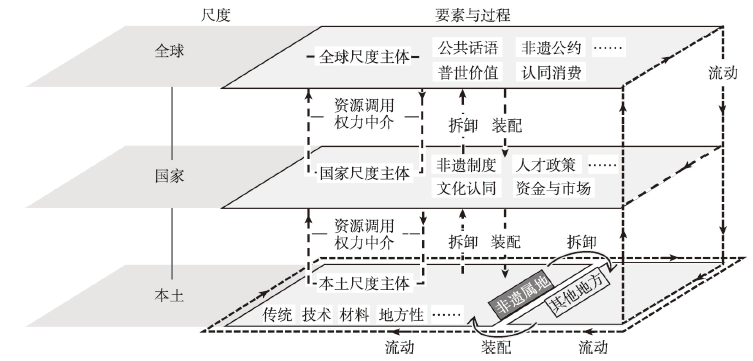

The translocal practices of intangible cultural heritage in the perspective of geography
Received date: 2020-08-13
Request revised date: 2021-08-17
Online published: 2022-04-19
Supported by
National Social Science Foundation of China(21BGL259)
Natural Science Foundation of Guangdong Province(2020A1515011381)
National Natural Science Foundation of China(41971184)
National Natural Science Foundation of China(41601135)
National Natural Science Foundation of China(18YJCZH271)
Copyright
Intangible cultural heritage (ICH) encompasses not only local traditional practice derived from the past, but also future-oriented modern cultural political and economic processes generated due to globalization. Therefore, this paper uses translocal theory as an entry point to move beyond the paradigm of localities in analyzing the socio-spatial processes of intangible cultural heritage, with a specific focus on the processes of formation, operation, and identity. Accordingly, this paper reconceptualizes the practice of ICH. Different from the prevailing rigid, intrinsically stable, and human-centered approach, this paper adopts the idea of translocal assemblage to consider ICH practices as rhizomatic networks. The network binds heterogeneous elements together by power mediation to form temporarily stabilized systems. The translocal assemblage of ICH practices firstly connects human and non-human components as well as tangible and intangible components in different localities. Second, due to the openness of the deep structure, a translocal assemblage is a complex, multifarious, non-linear, and unstable whole with exteriority. Lastly, the structural linkages woven by power relations improve the current flat understanding of the world and emphasize the need to distinguish the intensity and criticality of different connections. Case studies of Heqing silver-forging technology and Mosuo textile technology use the three aspects above to identify when and where heterogeneous elements are linked and influence local development. This paper further argues that for better safeguarding of ICH as well as promotion of local development by heritage practices, attention should be given to elements and processes beyond the local, including their interrelation mechanisms with the local place. In valuing the potential of intangible cultural heritage to support development strategies such as rural revitalization, the article calls for consideration of the impact of trans-localism on heritage authenticity and cultural values together with the enhanced linkages between intangible cultural heritage and local identities and livelihoods in the light of global production and consumption of heritages.

WEI Lei , ZHU Hong . The translocal practices of intangible cultural heritage in the perspective of geography[J]. Acta Geographica Sinica, 2022 , 77(2) : 492 -504 . DOI: 10.11821/dlxb202202015
表1 非遗实践中的流动、交换与循环Tab. 1 Translocal practices of intangible cultural heritage: Mobility, exchange, and circulation |
| 形式 | 表现 |
|---|---|
| 旅游利用中的冲突 | 根据旅游观光产业的需要,在本土和异地重新生产出非遗景观和非遗的表演空间。非遗的内涵、价值和表现形式由政府、商业资本、游客和本土社区多利益主体协商而成,利益的分配也常常充满争议。 |
| 非遗的空间移置 | 不同主体在本土之外的地方创建非遗展示、生产和消费的文化空间,非遗作为经济和文化资源,与本土之间的关系变得松散。 |
| 生产过程多地方整合 | 非遗的生产越来越依靠来自不同地方的劳动力、资金、理念、技术、原材料和市场,本土只承担了非遗生产中的特定环节,常常处于价值链较低端。 |
| 实践者的迁移和再地化 | 本地移民会带着非遗的技能、知识和理念等迁移,并在迁入地再地化,生产出新的非遗空间,通过移民的非遗实践,迁入地和迁出地之间发生连结。 |
| 遗产价值的尺度转换 | 非遗的价值被本土之外不同尺度的机构重新书写和认定,价值赋予的过程是本土和区域、国家、全球互动的过程。 |
| 非遗空间的虚拟化 | 网上博物馆、电子数据库和电子商务等非遗数字化的呈现方式,使非遗空间超越了物质时空和地点,这给本土社区提供了机遇,但也带来了威胁。 |
| [1] |
UNESCO. Basic Texts of the 2003 Convention for the Safeguarding of the Intangible Cultural Heritage (2016 Edition). Paris: UNESCO, 2016: 1-19.
|
| [2] |
|
| [3] |
[ 周尚意, 张晶. 地方性对地理标识性产品垄断利润形成的影响: 以苏州洞庭碧螺春为例. 地理科学, 2015, 35(11): 1357-1363.]
|
| [4] |
[ 戴俊骋, 李露. 非物质文化遗产旅游和地方建构. 旅游学刊, 2019, 34(5): 3-5.]
|
| [5] |
[ 吴康. 戏曲文化的空间扩散及其文化区演变: 以国家非物质文化遗产淮剧为例. 地理研究, 2009, 28(5): 1427-1438.]
|
| [6] |
[ 王淑佳, 孙九霞. 中国传统村落可持续发展评价体系构建与实证. 地理学报, 2021, 76(4): 921-938.]
|
| [7] |
[ 朱鹤, 刘家明, 桑子文, 等. 民族文化资源的类型特征及成因分析: 以格萨尔(果洛)文化生态保护实验区为例. 地理学报, 2017, 72(6): 1118-1132.]
|
| [8] |
[ 程乾, 凌素培. 中国非物质文化遗产的空间分布特征及影响因素分析. 地理科学, 2013, 33(10): 1166-1172.]
|
| [9] |
[ 王昕, 韦杰, 胡传东. 中国世界遗产的空间分布特征. 地理研究, 2010, 29(11): 2080-2088.]
|
| [10] |
|
| [11] |
|
| [12] |
|
| [13] |
|
| [14] |
|
| [15] |
[ 陶伟, 蔡浩辉, 高雨欣, 等. 身体地理学视角下非物质文化遗产的传承与实践. 地理学报, 2020, 75(10): 2256-2268.]
|
| [16] |
|
| [17] |
|
| [18] |
|
| [19] |
|
| [20] |
|
| [21] |
|
| [22] |
[ 李晓岑, 袁凯铮, 叶星生, 等. 西藏铜佛像制作“昌都工匠群”的考察. 中国藏学, 2010(3): 68-75.]
|
| [23] |
|
| [24] |
|
| [25] |
|
| [26] |
|
| [27] |
|
| [28] |
|
| [29] |
[ 孙九霞, 许泳霞. 文化资本化视角下“非遗”的表述与重构: 以丽江纳西刺绣为例. 思想战线, 2018, 44(3): 21-27.]
|
| [30] |
|
| [31] |
|
| [32] |
|
| [33] |
|
| [34] |
|
| [35] |
|
| [36] |
|
| [37] |
|
| [38] |
|
| [39] |
|
| [40] |
|
| [41] |
|
| [42] |
|
| [43] |
|
| [44] |
|
| [45] |
[ 袁振杰, 朱竑. 跨地方对话与地方重构: 从“炼狱”到“天堂”的石门坎. 人文地理, 2013, 28(2): 53-60.]
|
| [46] |
|
| [47] |
|
| [48] |
[ 何致中. 会遇其中: 会聚、相遇与中的对话. 区域与社会发展研究, 2017(8): 29-53.]
|
| [49] |
|
| [50] |
|
| [51] |
|
| [52] |
[ 郭文, 朱竑. 社会文化地理知识生产的表征与非表征维度. 地理科学, 2020, 40(7): 1039-1049.]
|
| [53] |
|
| [54] |
|
| [55] |
|
/
| 〈 |
|
〉 |